The Economics and Statistics Division maintains archives of previous publications for accountability purposes, but makes no updates to keep these documents current with the latest data revisions from Statistics Canada. As a result, information in older documents may not be accurate. Please exercise caution when referring to older documents. For the latest information and historical data, please contact the individual listed to the right.
<--- Return to Archive
For additional information relating to this article, please contact:
September 30, 2019NOVA SCOTIA QUARTERLY POPULATION ESTIMATES AS OF JULY 1, 2019 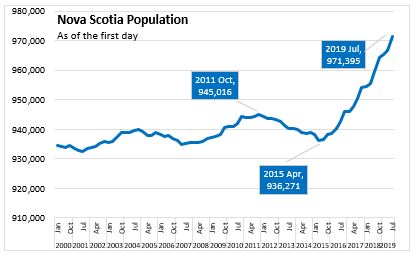
Nova Scotia’s population increased by 4,686 between April 1 and July 1, 2019. The population as of July 1, 2019 was 971,395 the highest population for Nova Scotia on record. Since April 1, 2015 Nova Scotia's population has increased by 35,124. This quarter's increase reflects an increase in immigrants, net non-permanent residents and net interprovincial migration offsetting the natural population change.

There are seasonal patterns in quarterly population changes, particularly evident in births and international migration. In the last four years, the second quarter has shown stronger population growth than the second quarter of the previous year. The quarterly population growth rate of 0.48 per cent is the largest for a second quarter since 1971.

In the last quarter, Nova Scotia’s population increased by 0.48 per cent compared to the April 1 estimate, the same rate as the national population. Compared with July 1, 2018 Nova Scotia’s population has increased by 1.24 per cent, or 11,895, while the national population grew by 1.43 per cent.
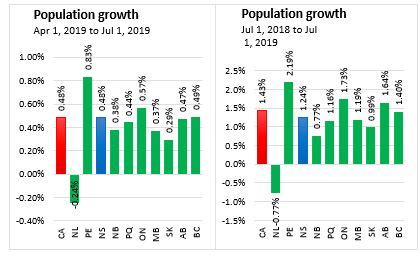
In recent years, immigration from other countries has been a strong contributor to population growth in Nova Scotia. Nova Scotia received 2,124 immigrants during the second quarter of 2019. Quarterly immigration continues to be higher than historical averages. Immigration of 2,124 in Q2 2019 is the highest level for any quarter for data that begins 1946 Q1.
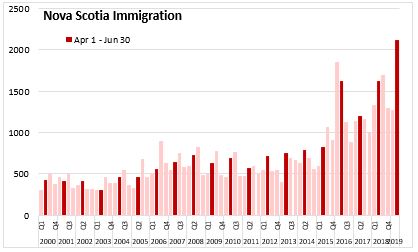
Net non-permanent residents can be a key component of quarterly demographic growth. In this quarter, Nova Scotia saw a net gain of 1,583 non-permanent residents since April 1, 2019.
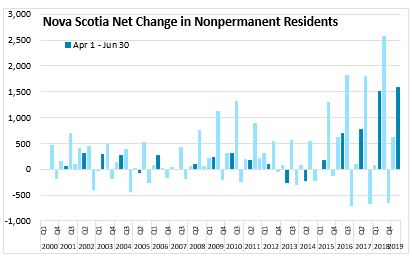
Nova Scotia’s natural population change (the number of births, less the number of deaths) has been negative for several years. Between April 1, 2019 and June 30, 2019, there were 2,191 births and 2,448 deaths, amounting to a natural population decline of 257.
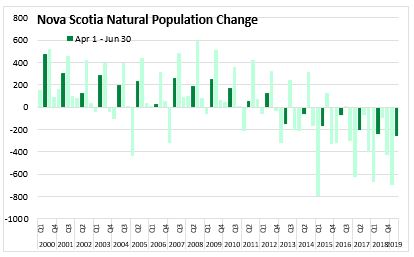
Interprovincial migration has historically shown a net outflow of Nova Scotia's population to other provinces. However, over the past four years, the population has grown through interprovincial movements. This quarter, Nova Scotia had a net inflow interprovincially of 1,281 persons similar to the gain in Q2 2018. There were net inflows from eight provinces.

Out-migration from Nova Scotia to other provinces increased compared to the second quarter of 2018. Out-migration increased to Ontario, Prince Edward Island, Quebec, Saskatchewan, Alberta, and British Columbia. Out-migration declined to New Brunswick and was mostly unchanged (less than 15 persons) to Newfoundland and Labrador and Manitoba.
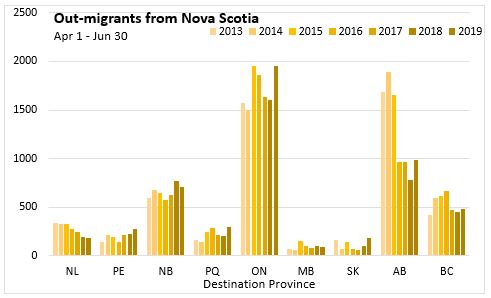
Compared to Q2 2018, in-migrants to Nova Scotia increased by 883 to 5,423 for Q2 2019. Higher levels of in-migrants from Newfoundland and Labrador, Prince Edward Island, Quebec, Ontario, and British Columbia occurred. There were fewer in-migrants from Alberta. In-migrant levels were mostly unchanged from New Brunswick, Manitoba, and Saskatchewan.
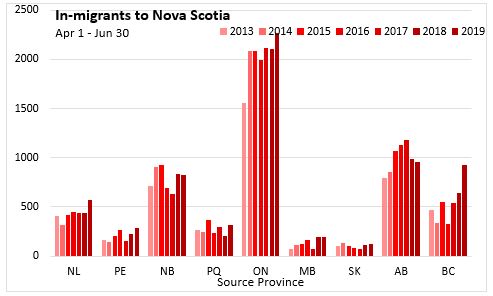
Interprovincial migration to Nova Scotia was a net inflow of 1,281 persons in Q2 2019. The largest net inflows came from British Columbia, Newfoundland and Labrador, and Ontario. Saskatchewan and Alberta were the only provinces with net outflows from Nova Scotia in Q2 2019.
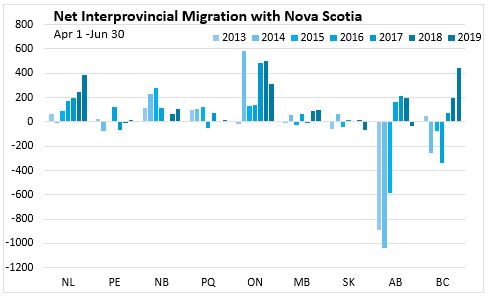
Source: Statistics Canada.
Table 17-10-0009-01 Population estimates, quarterly
Table 17-10-0020-01 Estimates of the components of interprovincial migration, quarterly
Table 17-10-0040-01 Estimates of the components of international migration, quarterly
Table 17-10-0045-01 Estimates of interprovincial migrants by province or territory of origin and destination, quarterly
Table 17-10-0059-01 Estimates of the components of natural increase, quarterly
<--- Return to Archive